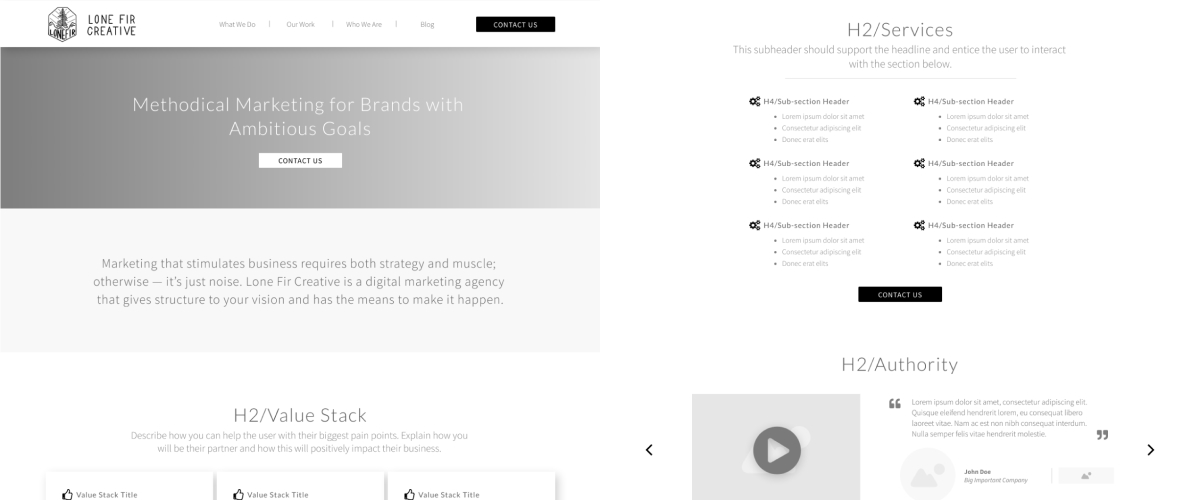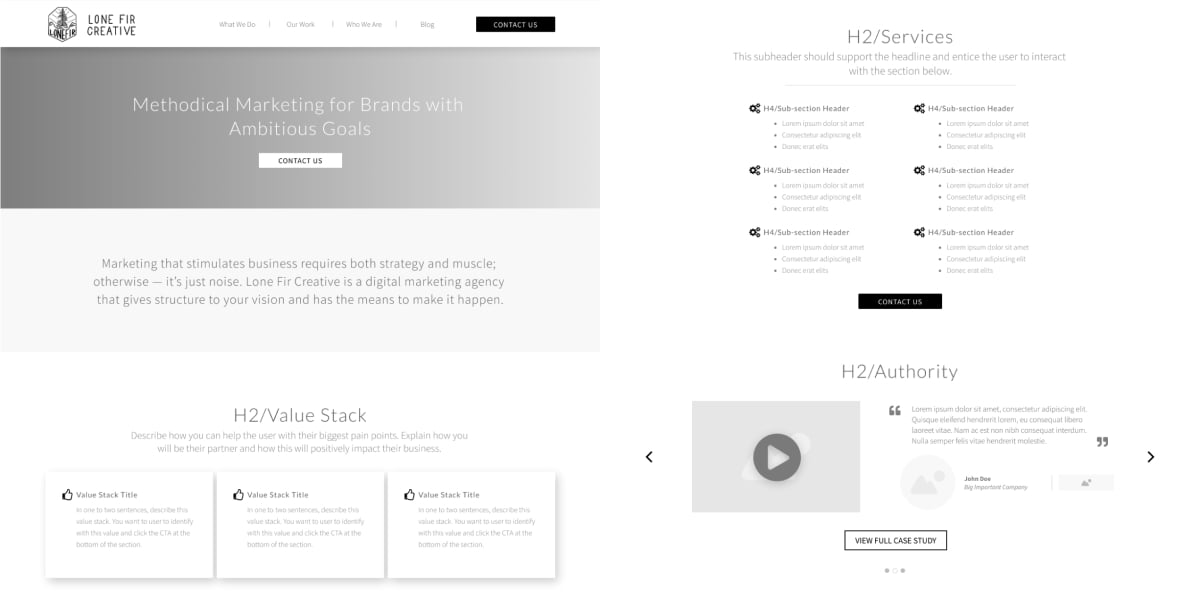You wouldn’t cook something new without a recipe, replace a part on your car without reading the manual or build a house without looking at the blueprints. We humans are pretty smart, but that doesn’t mean we can successfully create something from the top of our heads without any guidance. We need instructions to show us the way and keep us on track. That’s why you also shouldn’t build a website without a wireframe.
That’s right. Creating a wireframe comes before any other part of your website build because it will be your guide throughout the project. Your wireframe is the outline of your website that makes sure the outcome you want is the outcome you get.
Embarking on a website design without a wireframe can be frustrating. When you don’t have a plan for the flow of the page or a goal for the user experience, it’s not uncommon to hit roadblocks. Without a wireframe, you’ll often end up spending more time (and more money) parsing through revisions and refining your ideas in the design phase. This can be incredibly frustrating to navigate and might sour your taste for web designing altogether, even though a functional website is a great way to capture potential customers.
In short, wireframes are a crucial part of planning for the build of a website. They allow you to see how elements will relate to each other on a web page and provide ample room to explore options within the page layout before design is involved.
What Is a Wireframe?
Think of wireframes as the outline for each page of your site — bare bones, easy to read, devoid of any creative design elements (color, typography, graphics, etc.). When you keep all those extras out of view and focus on the core of how your user will interact with your website, you can keep functionality and the user experience front of mind.
When you set out to design a new website or even just a single web page, there’s a lot of assumptions about what should be added and what those elements should look like. If there isn’t a clear agreement in the early stages, then the web designers on your team might end up redoing pages two and three times until you find a consensus among everyone.
Putting on your blinders and looking at just the basic elements offers a lot of benefits for your development team.
First, wireframes force you to focus on the foundations and flow of your website instead of trying to do two things at once (lay out a site and start the design process). This way, all stakeholders can get on the same page about the foundational elements before moving on to things in design and development.
Second, in the event someone has an objection to the initial plan, wireframes are much easier to change than a flat design or developed page. They also provide a window for you to make your goals for the website clear. If you don’t have a clear picture of how your website will help your customers, then you’re likely to end up with a site that isn’t much more functional than your old one.
With wireframes, you can look at a few different layouts and possibly mix and match elements you like until you have the perfect combination. It’s an easy way to move through the brainstorming and preparation phases of a web design project without investing too heavily in any one idea.
5 Purposes Wireframes Serve In Your Overall Website Strategy

Wireframes aren’t just worth it from a design perspective. They can also help you to define and execute the overall strategy for your website. A well-crafted wireframe can ensure you have clear messaging, keep a narrative format throughout the pages and cater to the three “rights” — right content, right time, right place. Aside from these built-in accomplishments, there are five important purposes a wireframe serves for every website.
Displays a hierarchy of elements
Websites have a ton of moving pieces, and they all interact with each other to create the overall user experience. That’s why it’s so important to make sure every page, button and link on your website is part of a hierarchy that will lead your customers where you want them to go.
Wireframes make it easy to design this hierarchy because you quickly sketch out where each page will lead to. You can assign importance to certain areas of your website by placing them at the top of the hierarchy and get a visual representation of how other pages relate to it. This can make logically organizing your website much easier.
Discusses functionality
Wireframes allow you to focus on the customer journey more than the aesthetic experience. You can design a path through your website free of obstacles or distractions that might take your customer off your website.
For example, it’s easy for something as simple as a color or photo in your design to influence the feeling of an entire web page. These details can muddy people’s understanding of the goal of a page and make it difficult to see how the sections help the user. This is why when we wireframe, we always use grayscale colors and image placeholders so our clients aren’t distracted by small details. It helps them to see the overall goal of our proposed design and allows them to provide feedback on how we’ve structured narrative content that’s relevant to the customer journey.
Focusing on functionality helps your website bring customers exactly where you want them to go. This is one way to make sure your website is working for you and doing its part to increase conversions.
Allows for changes early and efficiently
Odds are you have more than one person with a say in how your website turns out. This means you have to take into account the opinions of a group for every decision during the design process. People don’t always see eye to eye, and you’ll likely have a few rounds of changes and revisions during the early stages.
If you start with the design phase of your website build and someone wants changes, it means going back into the template or builder, messing with code, toggling palettes and lots of other time-consuming tasks to get something just right. This can cost time and money and significantly set back your launch date.
To avoid all the hassle and cost, just use a wireframe! When you need to make a change to a wireframe, it’s as simple as erasing and drawing something new. It makes it much easier to get the overall functional design approved early so everyone is on the same page when you move into the more detailed areas.
Makes creating content streamlined and effective
Content is the beating heart of your site. It’s what informs people about your brand, convinces them to purchase from you and makes them feel connected to your purpose. It’s so important that it should be at the center of your website design.
Wireframes make it easy to layout your website based on content needs. You can set placeholders for images, videos, graphs and text so that it’s displayed exactly the way you want it and can inform the design of your website. You can make sure content flows smoothly from one page to the next so that everything feels connected and cohesive. Most importantly, you can structure the content on your site with a purpose so it helps you reach your goals.
Visualizes user-flows from page to page
Your website is made up of many different pages that all contribute to the overall goal of the site as a whole. Each of those individual pages, however, has a goal of their own. That’s why creating an effortless user flow is important to the success of a web page.
Each page on your website should have its own user flow to address the corresponding point in the customer journey that it’s catering to. For example, if a page is meant to inform a potential customer, it should have a clear flow that guides them through the key information about your product, then prompts them to view the product page.
You want to make sure the content on each web page is relevant to your customer’s needs at that stage in their experience. It’s the key principle of “the right content in the right place at the right time.” Having the next steps ready and waiting on each page also is crucial to creating a helpful user experience that guides customers to their goals.
Providing Effective Feedback on Wireframes
Wireframing can feel overwhelming, but it doesn’t have to be. It’s a highly collaborative process, so take advantage of the different viewpoints and expertise on your team. Everyone will have to come together to approve the wireframe, so allow anyone who’s interested to be part of its creation too.
The best thing to do is to let all those little details slip away for now. Don’t get hung up on what color your logo will be and what font you’ll use on the site, just focus on the most basic design elements. This way you can sketch out your big picture and fill in the blanks later.
You also want to consider what type of information is being communicated. Certain pages lend themselves better to different formats and types of information. Be sure to create a few options for yourself to find the best way to communicate your information to a wide audience. This might take a few tries, so don’t get discouraged if at first, you don’t succeed. Allow your team the time to get it just right in these early stages.
Once you make it through to a design everyone loves, there are four questions you can ask to determine if the wireframe, and ultimately the website, will be effective.
Does the section order align with the purpose of the page?
Think about what you’re hoping to get out of the page you’re designing. Is it a sales page meant to convert? Is it a blog meant to inform? The section order of your page should take your user on the journey that leads them to your goal. Allow your headers to guide people through the stages. If it’s a sales page, you want to start with what the product is, what it does, why it’s helpful, etc. If it’s a service page, you want to quickly mention your authority in the space, then gradually narrow it down so the user can learn about your specific service and how it will solve their problem.
Does it align with the customer journey?
You can’t forget about where customers are in their journey with your brand. Tailoring pages to specific stages in the customer journey can help you to more accurately relate the type of information users are looking for. It’s hard to convert a potential customer who’s still in the awareness stage, so create some pages that help educate them so they can move on to consideration and then make their decision.
Does it align with your goals?
Think of the overall goals you have for the website. The section order on any given page can help you reach those goals as well as individual page goals. When structured correctly, each page on a website works together to guide users toward a common destination. For example, if your goal is to boost sales, you can design your pages to gradually funnel people through to your sales page. It can guide them via blogs, landing pages and product spotlights so by the time the customer makes it to your sales page, they have all the information they need to make a decision.
Does it communicate the problem and how to solve it?
Keep in mind that the whole purpose of your products or services is to solve a problem. When people are perusing your website, they’re looking for how you’re going to improve their life; what problem will you solve? You need to keep the answer to this question front of mind throughout the web design process. Every page and the overall flow of your website should be sure to address the problem and present your solution.
Start Wireframing!
Now you know why wireframes are so critical to the web design process. They’re your blueprint to create a successful, effective website that everyone on your team will love and customers will be able to easily navigate. It keeps you from having to make costly revisions and can help to better inform the design process in the next stages of the project.
If you have more questions about wireframing or just want to know more about how a marketing or web design agency might approach this task, reach out to us! We love talking shop and would be happy to get you moving in the right direction.
? Keep Reading: Why Does Your Website Redesign Cost So Much?





